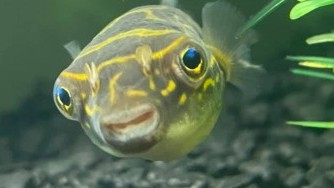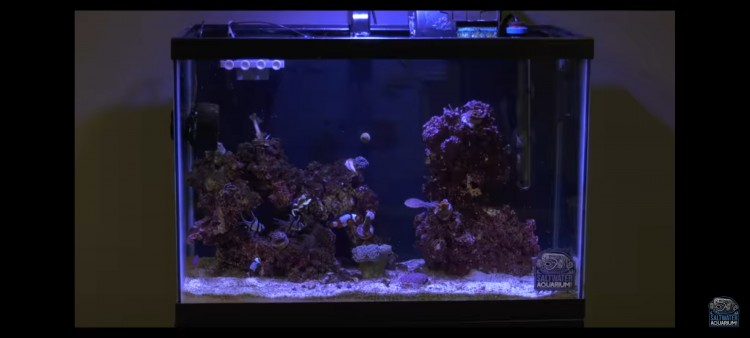Freshwater Pufferfish
- Jan 28, 2020
- PalaciosAn
- 10929 0 0

[Picture provided by Ethan Zoellner]
Pufferfish are cute-looking fish with tons of personality. They come in many different sizes and colors. They can be found all around the world, and some species can be challenging to keep in an aquarium. There are over 150 species of pufferfish, some with unique and peculiar hunting techniques.
There are approximately 30 different species of freshwaters pufferfish. Some of these species include popular species like the Amazon puffer, dwarf puffer, Redeye puffer, hairy puffer, spotted Congo puffer, golden puffer, crested puffer, Mbu puffer, and figure 8 puffer.
Keeping freshwater puffers as pets can be very rewarding. It can be mesmerizing watching these fish in action. However, you need to provide them with their basic needs to be successful.
Keep reading the article for more details on how to feed and care for them.
Can Freshwater Puffer Fish Live With Other Fish?
Freshwater puffers do not live well with other species. They can die of starvation since they are not fast enough to compete for food with other species. They also tend to nip other fish fins or even eat them, particularly during the breeding seasons. Therefore, keeping freshwater puffers with other fish can quickly become problematic.
Dwarf puffers can survive well in a sing special only tank with other Dwarf puffers. While this is true with some species, it is not the case with all species. Puffers have individual personalities, thus, keeping different species together can be quite unpredictable in an aquarium. Ambush or lurker species are predators by nature; therefore, keeping them in a tank with other fish is risky. Eventually, they will eat the other fish.
Pufferfish have different hunting techniques, such as:
- Stealth Predators - Species like the dwarf puffer, crested puffer, and red-tailed puffer are found in overgrown riverbanks. They prefer areas with several hiding spots so they can attack from the shadows.
- Open Waters Hunters - The South American and the Golden puffers prefer to swim over sandy substrate and rocks, as they look for their prey. You will find them swimming in oyster beds and through plants as they look for snails, small crustaceans, or clams to eat.
- Ambush Predators - Which includes the Congo puffer, which digs itself into the sand as they patiently wait for fish or invertebrates to come near so that they can kill them.
- Fin Nippers - Species like Chonerhinos and Auriglobus are notorious fin nippers. Other species try to blow water over the substrate to bring out hidden prey. Thus, they can also spit water at you as they ask for more food.
Are Freshwater Puffer Fish Poisonous?
Although freshwater puffers can appear to be very cute, they are also extremely aggressive. They usually will only puff themselves up with water as a protection mechanism. Their spine protrudes when inflated to prevent predators from eating them.
They also have a deadly neurotoxin referred to as tetrodotoxin, which they use as a defense mechanism from predators. Not all species of puffers are poisonous, and those that produce this venom don't do it directly. They do it by gathering bacteria from their diet in the wild that create tetrodotoxin. However, puffers in the aquarium are toxin-free because they don't have such foods.
Taking Care of Puffer Fish
Your freshwater puffers can live up to 10 years in an aquarium if you take good care of them. One of the biggest concerns when caring for pufferfish is caring for their teeth, for it is an essential aspect of their lives. They need to control the growth of their teeth. Feeding them with hard substrate animals like crustaceans, shellfish, and snails will help manage their teeth. If their teeth become too long, then you will need to clip/trim their teeth. If they grow too long, they will begin struggling when they try to eat.
It would be best if you also were careful when introducing new things in the aquarium to avoid diseases. Anything that you add to your aquarium can introduce potential bacteria and infection. Puffers are classified as scaleless fish; thus, without this line of defense, it makes them highly susceptible to diseases. For this reason, it is advisable to invest in a good filtration system.
What do Freshwater Puffers Feed On?
These species are found in brackish, marine and freshwaters. Although they are omnivores, they prefer a meat-based diet. Thus when in the wild, they eat crustaceans, shellfish, snails, and fish.
They will feed on anything when you place them in an aquarium. They can eat frozen, live, or dried meat. As they grow, you can give them small frozen fish like whitebait and lancetfish. Offer them plant-based food and vegetable at least once every week.
Every size has its different feeding habits, and you can avoid over or underfeeding them by using the following formulae:
- Feed small species every day.
- Feed mid-sized species every other day.
- Feed large species two to three times a week.
These intelligent fish are aggressive to other species, but they can try to impress you during feeding times by squirting water at the top of the tank. They will try to train you to feed them by doing this, thus avoid falling for their trick because you will overfeed them.






About author
I have been in the hobby for a while, my main focus is automation. I am interested in doing aquaponics in 2018.